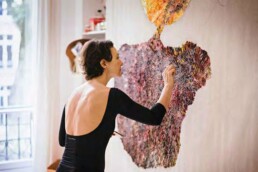JOSEFINA NELIMARKKA
Original interview on Art of Change 21 (English / French)
A Finnish interdisciplinary artist working between Helsinki and London, Josefina Nelimarkka’s site-specific work brings together art, science and technology to expand our relationship to the environment.
In her work, she brings the critical interactions between atmosphere, ecosystem and society into question as sensorial experiences.
Cloud Momentum © Josefina Nelimarkka
WHAT INSPIRED THE WORK THAT YOU CREATED FOR THE EXHIBITION "THE FRAGILE OCEAN"?
This installation is called ‘Cloud Momentum’ and relates to the phenomenon of ‘supersaturation’, my current subject of research.
Clouds are complicated ensembles of ambient motion and invisible micro events initiated by the condensation of tiny air particles in the atmosphere, known as aerosols. This incredibly brief yet crucial moment of transformation in cloud physics, ‘supersaturation’, is of great importance to our climate but is incomprehensible to us.
Therefore with this interactive installation and other glassworks that I’m working on now I want to bring to life what this process looks and sounds like.
Cloud Momentum © Josefina Nelimarkka
Cloud Momentum © Josefina Nelimarkka
The work changes constantly, and in the darkness of the exhibition space, the undulating movement of the lights becomes very atmospheric. How did you create it?
For Cloud Momentum I used atmospheric data collected above the North Atlantic and translated it into a continuous process which projects light onto cloud imagery. It’s hard to measure the clouds themselves so scientists measure cloud condensation data, which tells us when the aerosols form cloud droplets.
The LEDs are programmed to change in colour and speed according to the data. Since aerosols are extremely spontaneous, the process is very unpredictable. My interest in atmospheric motion also lies in its fundamental resistance of any stasis.
Josefina Nelimarkka © Francesca Tamse
What was the artistic journey you went on to arrive at this point?
A few years ago, I started having conversations with climate scientists and this revealed new perspectives to look at the world of atmospheric phenomena, clouds and climate modelling. There are so many unknown interactions in the atmosphere which are important to talk about.
My fascination with aerosols is that they are such a complex matter. Depending on their particular qualities, they influence the cloud’s properties and have far-reaching effects on the climate system by reflecting and absorbing sun radiation. There is also the question of air pollution. In my research exploring atmospheric climate, aerosols have become an ideal way to zoom into it.
This particular exhibition came out of an artist residency I undertook in Scotland. Earlier I had created work concerning aerosols in the forest and understanding the symbiotic relationship between the forest and the clouds. In Scotland, however, I started thinking about the Ocean and decided to look at marine clouds because they are quite different, since, for instance, the salt of the ocean affects the aerosols’ interaction.
It’s very important to my work that there is a specific meaning and connection between the data, the work and the experience. I choose environmental data carefully depending on the context.
Is there a general theme in your work?
With technology, like with art, we can have a personal relationship to something that we wouldn’t otherwise be able to. I’m interested in looking at the environment not just through what is visible, but also through that which we normally can’t see.
I like to work with the idea of a gradual experience that I hope the audience to perceive. During my exhibitions there’s always an ongoing process or a material change. One of the reasons why I like working with real-time data is because it can really expand the experience of the artwork once people know where the data is coming from. It makes both the work and the experience conscious.
It’s important to me that we think about what to do about the increasing amount of climate data in the world. Everyone should be able to understand it and see its potential. Art needs to react to this.
Another of Nelimarkka’s projects, the Kairos² AR app, allows us to see atmospherical aerosol particles normally invisible to the human eye © Josefina Nelimarkka
How do you relate to the term ‘environmental art’? What else has inspired your thinking?
Rather than ‘environmental art’, I often use the term ‘climate interaction’ because it’s all about allowing us to communicate better with our climate. However, for me this is about interaction with the environment as opposed to interaction between the audience and the work.
In my work I’ve been inspired by writers such as Roland Barthes and Maurice Blanchot. Both of them talk about ‘radical passivity’ – the absence or the silent space where language starts from.
In order to break your usual patterns of thought and create something new, you need to reinvent that absence. This has been a starting point for many of my processes because when I work with an unknown outcome, or something which is lost in the moment we have it – like the brief moment of an aerosol lifetime – I’m always dealing with a space of possibility.
In terms of the environment and climate change we also need this break from conventions. This is why I chose to have this more philosophical angle to the environment rather than talking about politics directly. My work is more about subtle experiences and poetic imagination because I think this can trigger a space of possibility, whether it’s threatening, hopeful or both.
Josefina Nelimarrka’s most recent projects include the London-based exhibition ‘The Fragile Ocean’, organised by Sail Britain and super/collider; ‘Time Resides’ at Solid Art, Taiwan; artist residencies at SPACE Art + Technology, London and climate research station SMEAR II, Finland; and the creation of a mobile app, Kairos² AR. She is currently working on a real-time cloud experience for a Swedish public commission.









